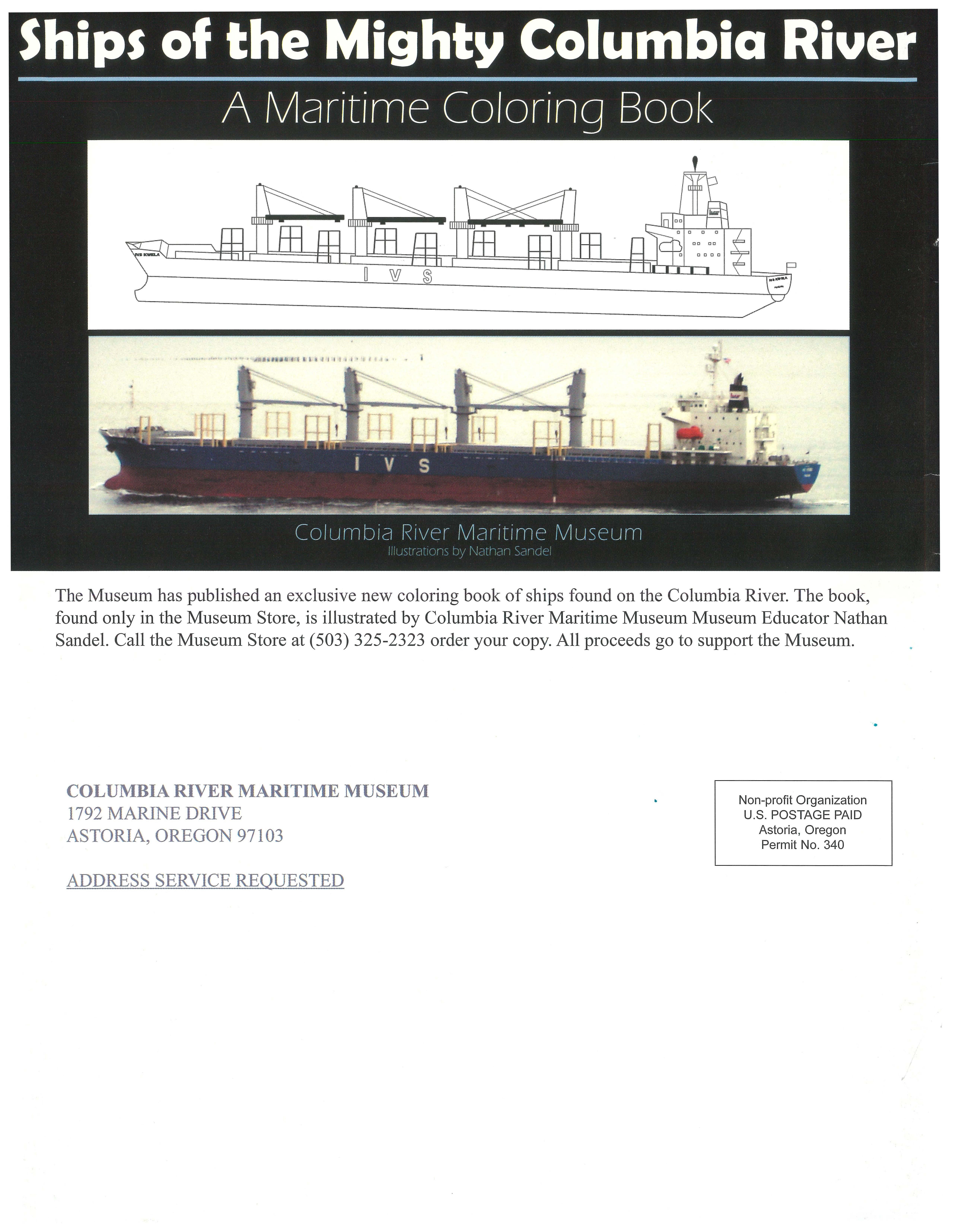




for the Museum . I am honored to serve as the Acting Executive Director during this transition phase
As winter arrives at the mouth of the Columbia River, this year is proving to be as the local fishermen had predicted, a much colder winter than the last few we have experienced. The cover photo for this issue of the QuarterDeck shows thirty-foot swells impacting the South Jetty after a December storm. One never quite adjusts to the stunning display of nature's power as witnessed on the Oregon Coast.
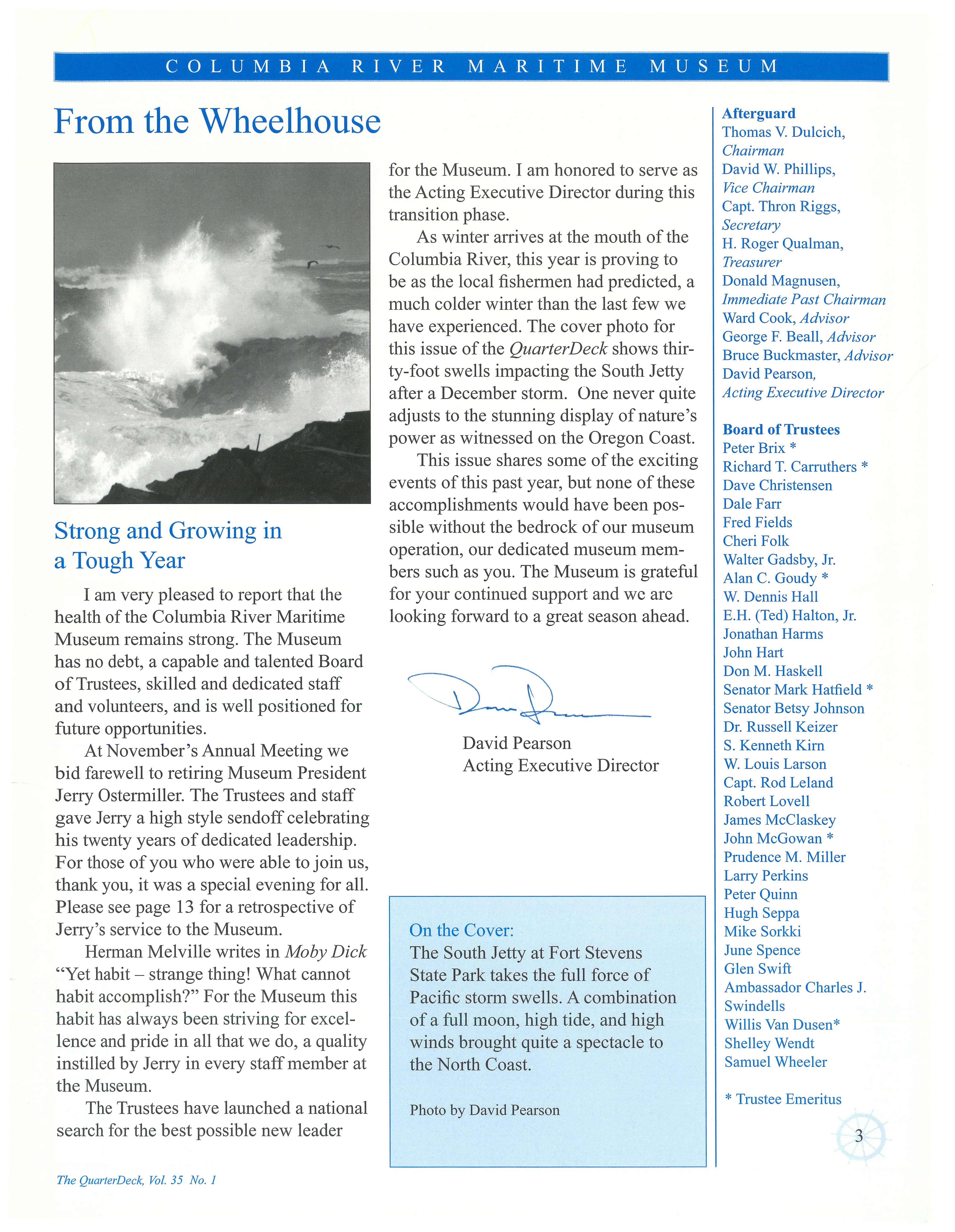
Thomas V. Dulcich, Chairman
David W. Phillips, Vice Chairman
Capt. Thron Riggs, Secretary
H . Roger Qualman, Treasurer
Donald Magnusen, Immediate Past Chairman Ward Cook, Advisor
George F. Beall, Advisor Bruce Buckmaster, Advisor David Pearson, Acting Executive Director
Peter Brix*
I am very pleased to report that the health of the Columbia River Maritime Museum remains strong. The Museum has no debt, a capable and talented Board of Trustees, skilled and dedicated staff and volunteers, and is well positioned for future opportunities.
At November ' s Annual Meeting we bid farewell to retiring Museum President Jerry Ostermiller. The Trustees and staff gave Jerry a high style sendoff celebrating his twenty years of dedicated leadership. For those of you who were able to join us, thank you, it was a special evening for all. Please see page 13 for a retrospective of Jerry's service to the Museum.
Herman Melville writes in Moby Dick "Yet habit strange thing! What cannot habit accomplish?" For the Museum this habit has always been striving for excellence and pride in all that we do, a quality instilled by Jerry in every staff member at the Museum.
The Trustees have launched a national search for the best possible new leader
This issue shares some of the exciting events of this past year, but none of these accomplishments would have been possible without the bedrock of our museum operation, our dedicated museum members such as you. The Museum is grateful for your continued support and wc arc looking forward to a great season ahead.
Richard T. Carruthers * Dave Christensen
Dale Farr
Fred Fields
Cheri Folk
Walter Gadsby, Jr.
Alan C. Goudy * W. Dennis Hall
E H. (Ted) Halton, Jr. Jonathan Harms
John Hart
Don M. Haskell
Senator Mark Hatfield * Senator Betsy Johnson Dr Russell Keizer
David Pearson Acting Executive DirectorS. Kenneth Kim W. Louis Larson
Capt. Rod Leland
Robert Lovell
James McClaskey
John McGowan * Prudence M. Miller
Larry Perkins
Peter Quinn
Hugh Seppa
The South Jetty at Fort Stevens State Park takes the full force of Pacific storm swells. A combination of a full moon, high tide, and high winds brought quite a spectacle to the North Coast.
Mike Sorkki
June Spence
Glen Swift
Ambassador Charles J. Swindells
Willis Van Dusen* Shelley Wendt Samuel Wheeler
* Trustee Emeritus
The autumn crispness could be felt as the audience gathered on the Museum plaza for a very special ceremony the afternoon of September 26. A Chinookan canoe and drummers draped in red and black ceremonial robes gathered near the flag pole.
The Museum was given the honor of being the first organization to receive the Chinook Nation flag. This gift signified the beginning of a partnership between the tribe and the Museum. Ray Gardner, Chinook Council Chairperson, began the auspicious occasion by greeting the audience and sharing his lineage Gardner spoke of the Chinook's traditional home lands and their history in the region .
Dave Pearson, Acting Executive Director; Blue Anderson, Store Manager; and Betsey Ellerbroek, Education Director, were then asked to join Ray at the podium . Each manager was presented
with a handcrafted necklace by Chairperson Gardner signifying the importance of the bond . The Chinook flag was given to Pearson who then, with Hampton Scudder's assistance, hoisted the flag. Tribal member, Tony Johnson greeted the crowd by speaking in Chinook. He translated his message and then joined the singers and drummers at the flag pole.
The Museum is extremely honored by the Chinook gift and will work to establish a close relationship through educational programs, research, and trade.
The inspiration for this ceremony materialized when Blue Anderson, Museum Store Manager, approached the Chinook Nation about selling some of the tribe's merchandise in the Store. It was apparent that this was also a unique opportunity to develop a relationship between the Education Department and the Chinook Nation . Many conversations took place regarding

this alliance and culminated with the flag gifting ceremony.
Education Director Betsey Ellerbroek summed up the occasion with the following words.
"Thank you Ray, Tribal Elders, Jody and Don for honoring us today with a ceremonial flag of the Chinook Nation. No one can deny the value of education and the importance it plays in sustaining cultures. Education is a core foundation of society. The Columbia River Maritime Museum is dedicated to inspiring people through our exhibits and education programs. It is our responsibility to interpret the stories of all cultures who live or have lived near the river and depend upon it. We are interconnected by this common thread the Columbia. The Columbia River is not just a body of water but an economic highway, a home to living things, and a watershed that connects every living thing as part of a larger community. It is this sense of place that remains important to all of us and helps us make
connections. These connections assist us in understanding our neighbors in this region, understanding our differences, beliefs and our pasts. As lifelong learners we must understand the history of the river, the many cultures who call it home, and the importance of our environment.
I look forward to learning from Chinook members and working closely with the Chinook Cultural Committee and gaining their assistance in helping to tell the Chinook story. Thank you for being here today, bringing your canoe, and teaching us a bit about your culture."

Febuary 27, 1946
In this issue of the QuarterDeck we take another look at the archives of the Museum Library. The Dungeness Crab industry has become one of the strongest fisheries in the Pacific Northwest. The commercial crabbing industry developed relatively late off the Oregon Coast gain ing vitality in the 1930s
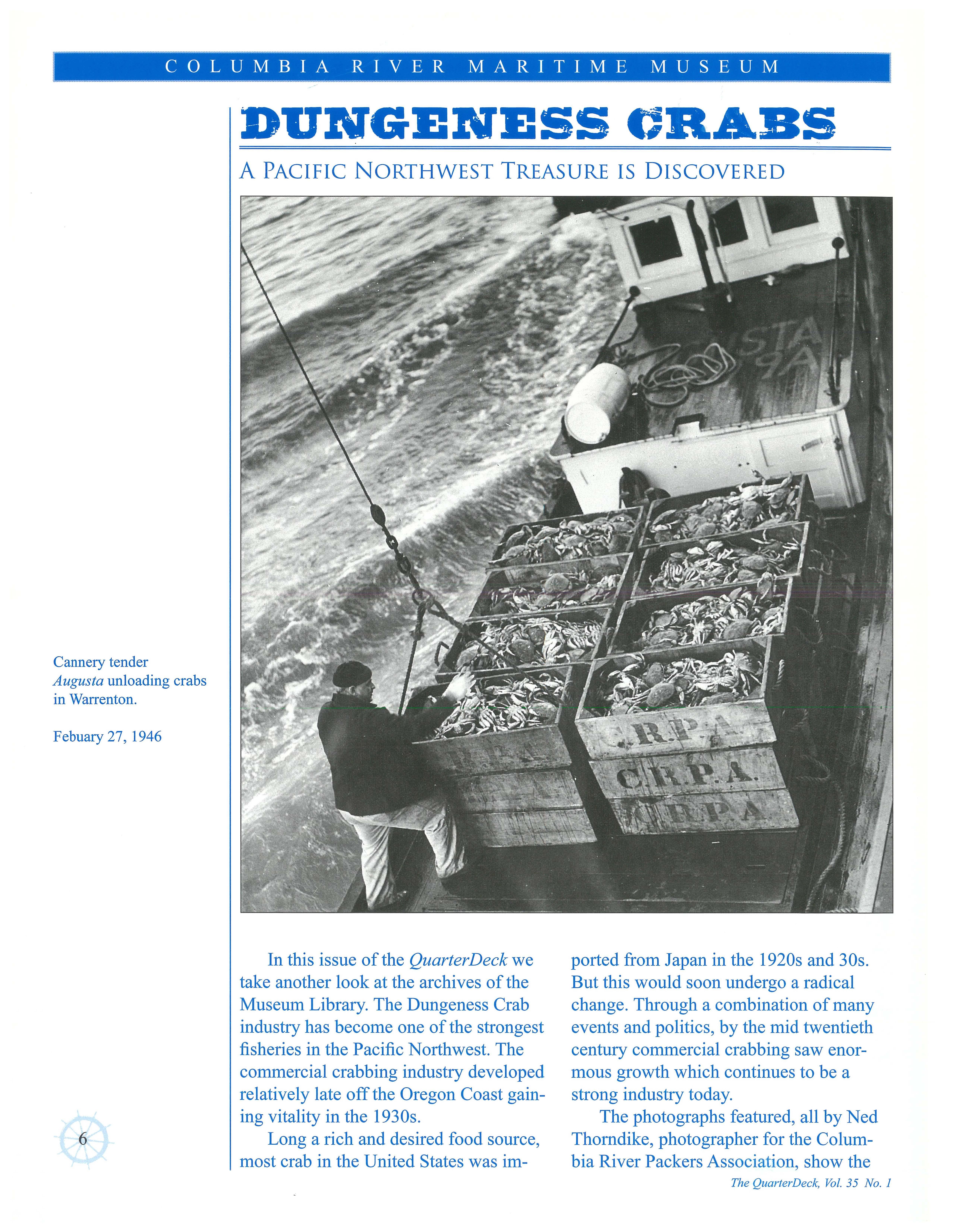
Long a rich and desired food source, most crab in the United States was im-
ported from Japan in the 1920s and 30s But this would soon undergo a radical change. Through a combination of many events and politics, by the mid twentieth century commercial crabbing saw enormous growth which continues to be a strong industry today.
The photographs featured, all by Ned Thorndike, photographer for the Columbia River Packers Association, show the
industry at its start.
Pacific Fisherman featured an insider's look at the crabbing industry in its 1943 Yearbook. We have reprinted sections here to tell that story.
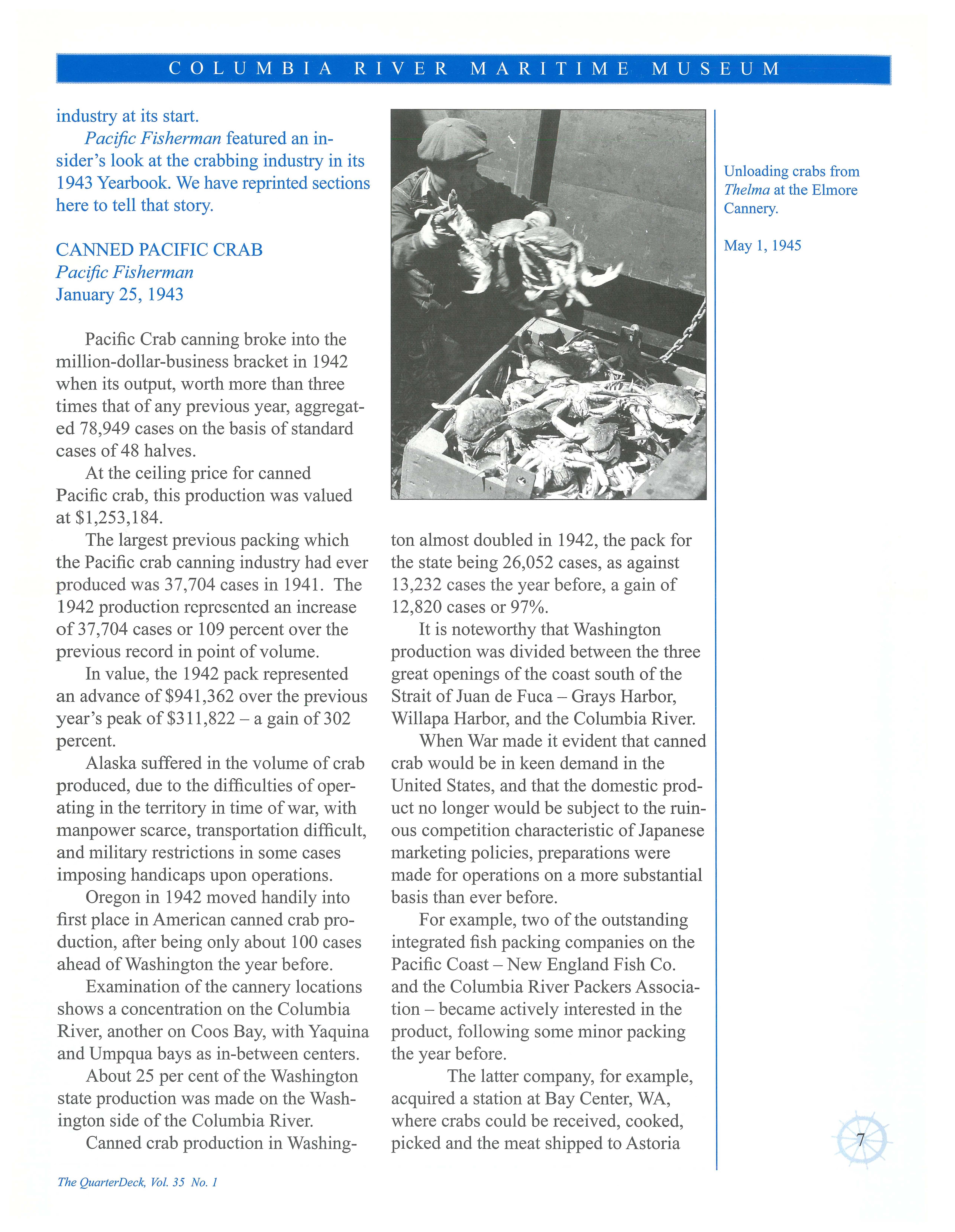
Pacific Fisherman
January 25, 1943
Pacific Crab canning broke into the million-dollar-business bracket in 1942 when its output, worth more than three times that of any previous year, aggregated 78,949 cases on the basis of standard cases of 48 halves.
At the ceiling price for canned Pacific crab, this production was valued at $1,253,184.
The largest previous packing which the Pacific crab canning industry had ever produced was 37,704 cases in 1941. The 1942 production represented an increase of 37,704 cases or 109 percent over the previous record in point of volume.
In value, the 1942 pack represented an advance of $941,362 over the previous year's peak of $311,822 a gain of302 percent.
Alaska suffered in the volume of crab produced, due to the difficulties of operating in the territory in time of war, with manpower scarce, transportation difficult, and military restrictions in some cases imposing handicaps upon operations.
Oregon in 1942 moved handily into first place in American canned crab production, after being only about 100 cases ahead of Washington the year before.
Examination of the cannery locations shows a concentration on the Columbia River, another on Coos Bay, with Yaquina and Umpqua bays as in-between centers.
About 25 per cent of the Washington state production was made on the Washington side of the Columbia River.
Canned crab production in Washing-
ton almost doubled in 1942, the pack for the state being 26,052 cases, as against 13,232 cases the year before, a gain of 12,820 cases or 97%.
It is noteworthy that Washington production was divided between the three great openings of the coast south of the Strait of Juan de Fuca- Grays Harbor, Willapa Harbor, and the Columbia River.
When War made it evident that canned crab would be in keen demand in the United States, and that the domestic product no longer would be subject to the ruinous competition characteristic of Japanese marketing policies, preparations were made for operations on a more substantial basis than ever before.
For example, two of the outstanding integrated fish packing companies on the Pacific Coast New England Fish Co. and the Columbia River Packers Association became actively interested in the product, following some minor packing the year before.
The latter company, for example, acquired a station at Bay Center, WA, where crabs could be received, cooked, picked and the meat shipped to Astoria
Unloading 19,000 pounds of crab from North Shore at the Elmore Cannery.
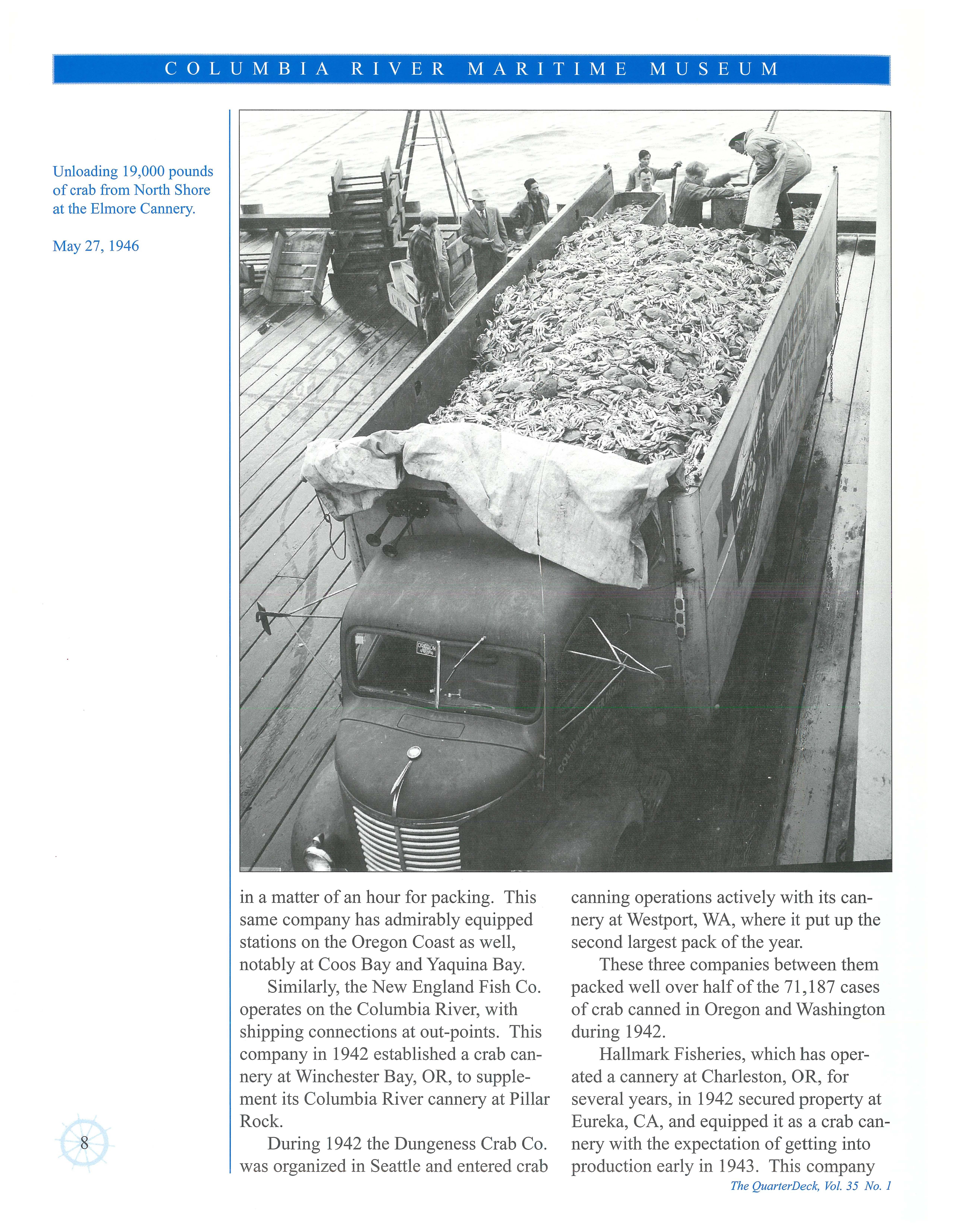
May 27, 1946
in a matter of an hour for packing. This same company has admirably equipped stations on the Oregon Coast as well, notably at Coos Bay and Yaquina Bay.
Similarly, the New England Fish Co. operates on the Columbia River, with shipping connections at out-points This company in 1942 established a crab cannery at Winchester Bay, OR, to supplement its Columbia River cannery at Pillar Rock.
During 1942 the Dungeness Crab Co. was organized in Seattle and entered crab
canning operations actively with its cannery at Westport, WA, where it put up the second largest pack of the year.
These three companies between them packed well over half of the 71,187 cases of crab canned in Oregon and Washington during 1942
Hallmark Fisheries, which has operated a cannery at Charleston, OR, for several years, in 1942 secured property at Eureka, CA, and equipped it as a crab cannery with the expectation of getting into production early in 1943 . This company
at its Charleston plant in 1942 initiated the plan of installing extra lighting in order to permit picking the crabmeat at night. This practice made it possible to handle the crabs immediately after landing and with delay reduced to a minimum.
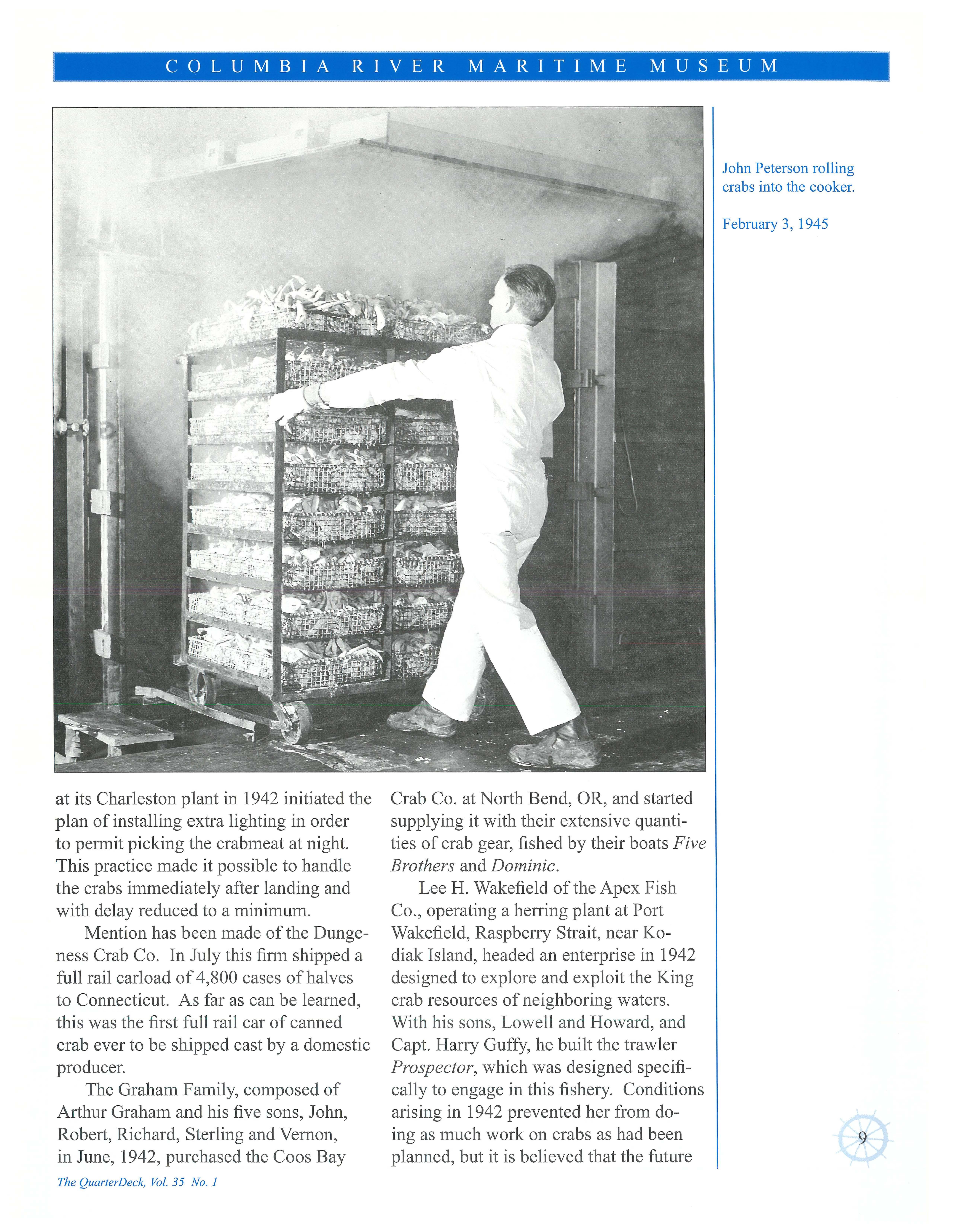
Mention has been made of the Dungeness Crab Co. In July this firm shipped a full rail carload of 4,800 cases of halves to Connecticut. As far as can be learned, this was the first full rail car of canned crab ever to be shipped east by a domestic producer.
The Graham Family, composed of Arthur Graham and his five sons, John, Robert, Richard, Sterling and Vernon, in June, 1942, purchased the Coos Bay
Crab Co. at North Bend, OR, and started supplying it with their extensive quantities of crab gear, fished by their boats Five Brothers and Dominic.
Lee H. Wakefield of the Apex Fish Co., operating a herring plant at Port Wakefield, Raspberry Strait, near Kodiak Island, headed an enterprise in 1942 designed to explore and exploit the King crab resources of neighboring waters. With his sons, Lowell and Howard, and Capt. Harry Guffy, he built the trawler Prospector, which was designed specifically to engage in this fishery. Conditions arising in 1942 prevented her from doing as much work on crabs as had been planned, but it is believed that the future
January 1, 1946
well may find this vessel as the forerunner of a fleet which will develop the latent King crab fisheries of the Gulf of Alaska and Bering Sea.
CRAB FISHING shares with shark fishing, trawling and albacore fishing the distinction of having made spectacular gains in importance in recent years. Not only has the volume of the catch increased, but the value of the products derived from it has advanced largely, due essentially to the increasing degree to which the catch is being canned.
Crab canning in particular leaped ahead in importance in 1942.
This is not at all surprising in view of the fact that the great majority of the canned crab formerly consumed in the United States came from Japan. Restric-
tion of the imports of this product did not wait upon actual war, but followed abrogation of the trade and navigation treaty with Japan at the start of 1940.
Following announcement of that abrogation, but before it became effective, Japan flooded the United States market with unprecedented quantities of canned crab, which were priced at market-capturing levels. There was no great incentive for packing American canned crab in 1940 and 1941 in the face of such crippling competition, and indeed the Japanese crab exerted an adverse effect upon the American industry long after the actual outbreak of war.
THREE VARIETIES of crab are available on the Pacific Coast in quantities sufficient for canning the Pacific or Dunge-
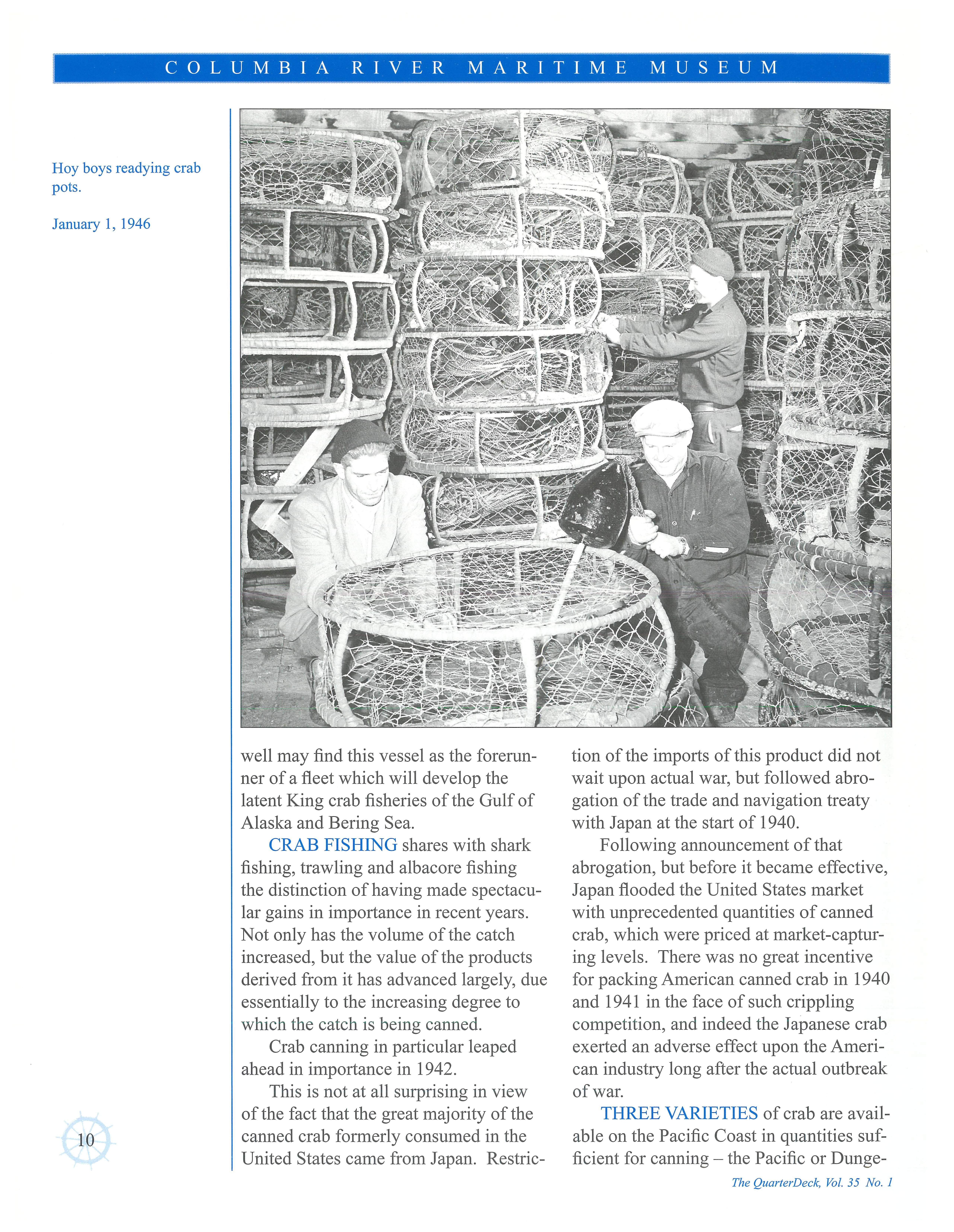
ness crab, the King crab, and the Tanner crab. It may eventually be possible to add one or two other varieties to this list, but at present only three species appear to have commercial possibilities.
Of the three crab available for canning, only the Pacific or Dungeness species (Cancer magister) has sustained any material fishery over a period of years. This is the crab which has been used widely in the fresh state in the markets of California, Oregon, Washington, British Columbia and Alaska for many years.
It is most highly esteemed both fresh and canned, where its flavor and texture are recognized as far and away ahead of other varieties of crab.
The King crab is the species upon which the Japanese pack is based. As a
matter of fact, ofrecent years the Japanese, with their :floating canneries, systematically invaded the waters of Bering Sea and Bristol Bay off the coast of Alaska and have taken a large portion of their catch along the American coast.
Tardy investigations by United States government agencies have shown that the King crabs abound in the Bering Sea, and that there are smaller, although substantial, populations along the south side of the Alaska Peninsula, in the waters surrounding Kodiak and other islands in the Gulf of Alaska, as well as in the lower portion of Cook Inlet.
Canning of this variety has been undertaken by private operators to a nominal extent, but it is not anticipated that it can become of great importance until the mili-

tary situation in Alaska is clarified .
Tanner crab is found widely in Alas kan water, and particularly in those which the King crab has been found to inhabit. Although this species of crab has not been exploited commercially to any material extent , it is edible and desirable and evidently abundant to a degree which indicates that it may become an important factor in meeting the American demand for canned crab with a domestic product.
PACIFIC CRAB is often known as Dungeness Crab, a name which it draws from the little town of Dungeness, WA, on the Strait of Juan de Fuca. This town was formerly the center of a crab fishery, but its production is no longer of any real consequence in the expanded industry
The Pacific crab is found in varying abundance along the Pacific Coast from Dutch Harbor to Magdalena Bay, Mexico. The limits of the commercial fishery for the species are Prince William Sound on the north and San Francisco Bay on the south. It appears probable that present production centers on the Oregon Coast, where crab fishing in the past half dozen years has risen from comparative unimportance to one of the leading aquatic industries .
Fisheries for the Pacific crab rise and fall in productivity with the intensity and duration of fishing effort. The species appear rather easily to recover from overfishing, if depletion is not too far advanced before relief is accorded . In general, the occurrence of the crab corresponds with areas of sandy bottom and relatively shallow water.
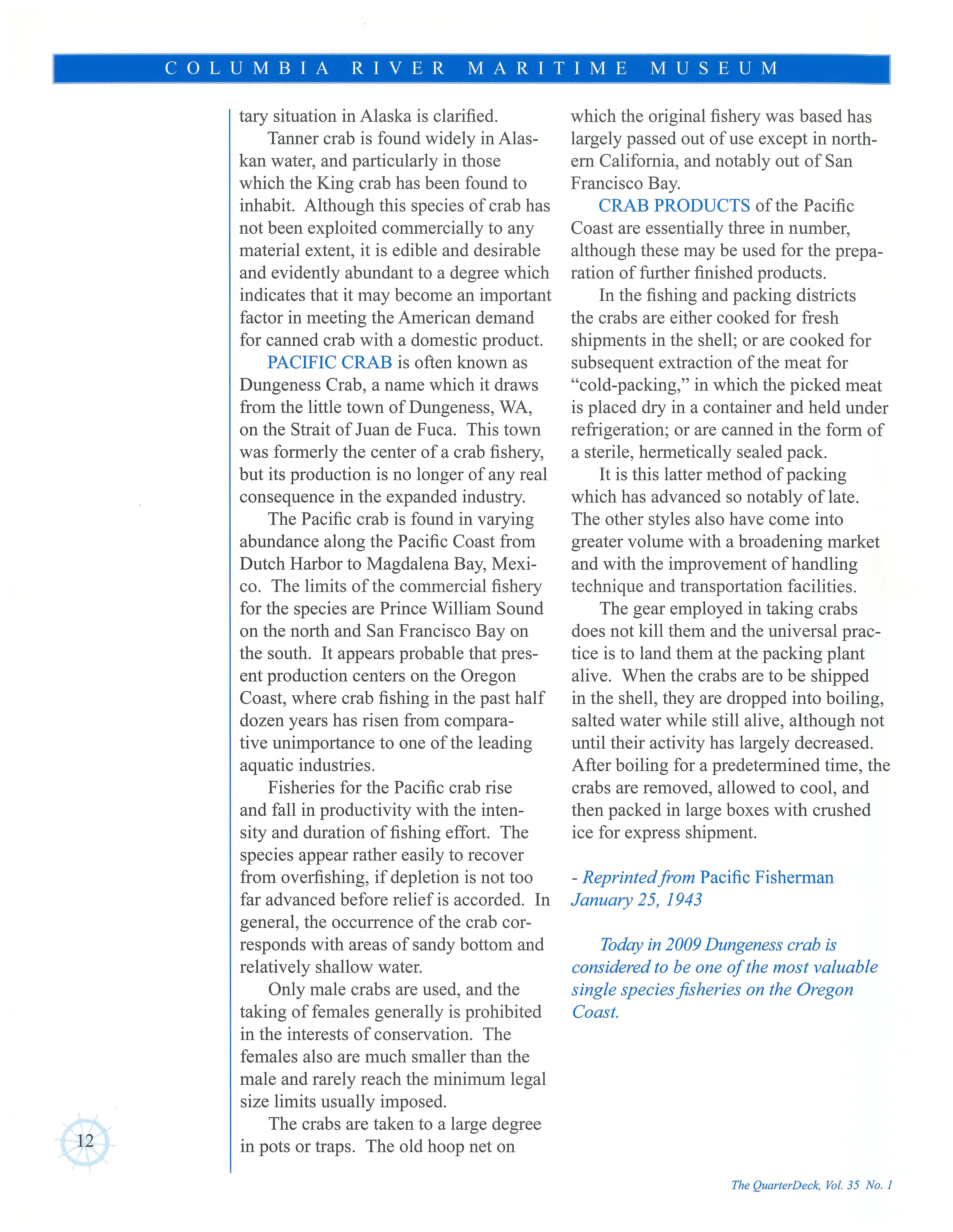
Only male crabs are used, and the taking of females generally is prohibited in the interests of conservation The females also are much smaller than the male and rarely reach the minimum legal size limits usually imposed.
The crabs are taken to a large degree in pots or traps. The old hoop net on
which the original fishery was based has largely passed out of use except in northern California, and notably out of San Francisco Bay.
CRAB PRODUCTS of the Pacific Coast are essentially three in number, although these may be used for the preparation of further finished products.
In the fishing and packing districts the crabs are either cooked for fresh shipments in the shell; or are cooked for subsequent extraction of the meat for "cold-packing," in which the picked meat is placed dry in a container and held under refrigeration; or are canned in the form of a sterile, hermetically sealed pack.
It is this latter method of packing which has advanced so notably of late. The other styles also have come into greater volume with a broadening market and with the improvement of handling technique and transportation facilities
The gear employed in taking crabs does not kill them and the universal practice is to land them at the packing plant alive . When the crabs are to be shipped in the shell, they are dropped into boiling, salted water while still alive, although not until their activity has largely decreased. After boiling for a predetermined time, the crabs are removed, allowed to cool, and then packed in large boxes with crushed ice for express shipment.
Today in 2009 Dungeness crab is considered to be one of the most valuable single species fisheries on the Oregon Coast
Longtime Museum leader Jerry Ostermiller announced his departure from the Museum after twenty years of dedicated service.
Fresh from Idaho, Jerry began working at the Columbia River Maritime Museum as the Executive Director in 1989 At that time the Museum still had a trailer park located in front of the building, which was just purchased by the Museum to create a parking lot. Today, through Jerry's leadership and tireless efforts the Museum has become a nationally known maritime museum with over 100,000 visitors each year
Jerry has left behind many lasting legacies, accomplishments, and friendships along the way. We wish him all the best in all of his future endeavors. Jerry will always be part of the Museum family.
Under Jerry's Watch
• Museum operations expanded to seven days a week
• American Association of State and Local History Award for Year of the Fisherman
• Lightship Columbia placed on National Register of Historic Places
• CRMM declared by state legislators to be "Oregon's Official Maritime Museum"
• Museum Re-accredited by the American Association of Museums
• New 17th Street dock built
• Negotiated for USS Missouri to visit Astoria
• Armory Storage Building purchased and phase 1 improvements initiated
• 6 million dollar remodel of Museum completed May 12, 2002
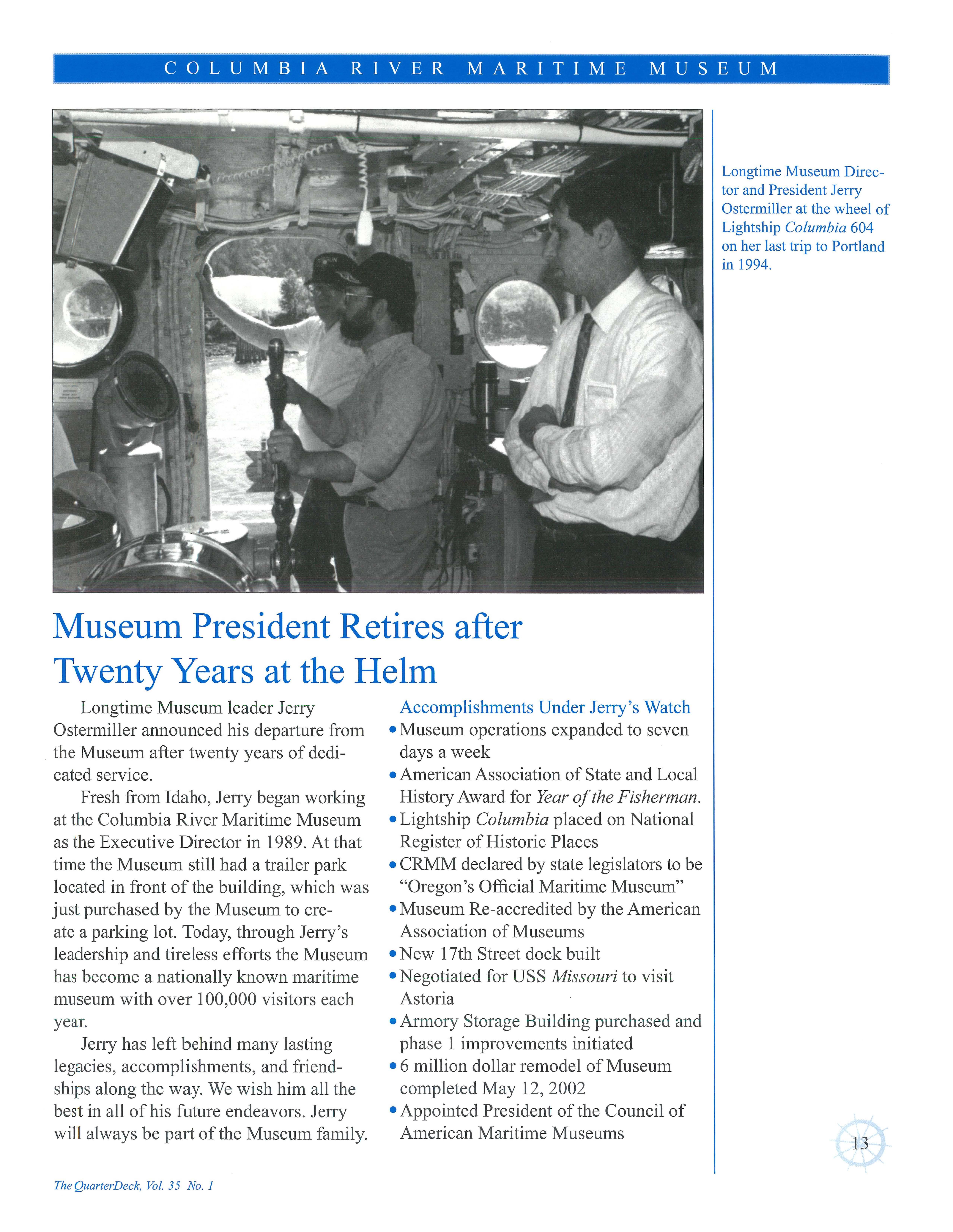
• Appointed President of the Council of American Maritime Museums
Longtime Museum Director and President Jerry Ostermiller at the wheel of Lightship Columbia 604 on her last trip to Portland in 1994.
Museum Staff:
Blue Anderson
Celerino Bebeloni
Ron Becerra
Linda Bowen
Ann Bronson
Lee Clinton
Josh Cooper
Betsey Ellerbroek
Bob Hagen
Helen Hon!
Kathy Johnson
Arline LaMear
Jack Mills
David Pearson
Nathan Sandel
Hampton Scudder
Cheryl Silverblatt
Jeff Smith
Janna Smith
Steve Swenson
Patric Valade
Jackie Welborn

• Monday mornings will be a special time for parents, or grandparents, with young children. Museum Mates is an activity based preschool program for four and five year olds. Children and their parent or grandparent will explore the maritime world through stories, songs, exhibit searches and crafts. Every Monday from 9:30 to 10:30 our Education Department staff will focus on a different theme that leads the children and their family member on a voyage of discovery through the Museum. Preschoolers must be accompanied by an adult. This program is free to members. Call the Museum for more details.
• The Education Department had a fantastic year in 2008 breaking previous records. The Museum in the Schools outreach program served over 4,000 students in five counties. This summer 4,500 people participated in Family Programs, which was 2,000 more people than in previous summers. Our success is due in part through the continuous support from Quest for Truth Foundation who donated $30,000 for education programs. Friends of Columbia River Maritime Museum also added their support by writing a check for $3,000 to the Education Department. We would also like to thank Englund Marine and Industrial Supply for donating two life rafts and survival suits. When these rafts are set up in the Ford Family Room or lobby no one can pass up the opportunity to look inside and imagine what it would be like to be adrift at sea in one.
• Coast Guard Group Astoria and CRMM President Jerry Ostermiller welcome retired Coast Guard Master Chief Ken Long who presented a scratch-built model of the buoy tender Iris. CRMM is honored to have this model in its collection.
• To observe the first anniversary of the devastating Great Coastal Gale of 2007 the Museum held an event entitled " Weathering the Storm " sponsored by Pacific Power, TLC Federal Credit Union, Quest for Truth Foundation and The Daily Astorian . Over six hundred people took advantage of this free day to learn more about the storm from National Weather Service's Tyree Wilde, Debbie Guerra from Pacific Power and Coast Guard Rescue Swimmer Ron Tremain. Admission was free with canned food or monetary donations to the Clatsop County Action Regional Food Bank. Almost 1,000 pounds of food was donated for this worthy cause. Pacific Power's display demonstrating the dangers of downed power lines was a huge draw to people of all ages. This community appreciation day is sure to become an annual event.
We bid farewell to Lorraine Ortiz from the Museum. Lorraine has been a key part of our operations and will be greatly missed. We wish her all the best.
We welcome Lee Clinton aboard as our new Communications and Membership Manager. Lee brings a wealth of experience in non-profit membership and event management to the Museum. Stay tuned for some exciting new programs for Museum memhers this season.
Drift Boats and River Dories
Roger Fletcher
Saturday, March 28th at 2 :30 pm
A gifted and enthused speaker, Roger Fletcher brings his research to life. Using his models of the re-created originals he spins fascinating tales about the men and the women behind the boats. The listener becomes enthralled with these early river running pioneers as Roger weaves the exciting, curious and dynamic stories about these " eddies of evolution."
Lighthouses and Life-Saving on the Oregon and Washington Coasts Saturday, April 4th William Hanable at 11 :30 am David Pinyerd at 2 :30 pm
Dont miss this exciting day of presentations and book signing from two dynamic authors and presenters on Lighthouses and Lifesaving.
The first Oregon lighthouse was built in 1857 at the Umpqua River. The LifeSaving Service followed in 1878 with a station at the mouth of Coos Bay. Eventually, most of the harbor entrances and headlands were protected by both the Lighthouse Service and the Life-Saving Service. David Pinyerd will share his
knowledge about the true heroes who served to warn, protect, and rescue those who went to sea.
William Hanable will give an engaging talk about preservation efforts to save our historic light stations and also the condition of Oregon's lighthouses today.
The winter speaker series, Past to Present: Columbia River Maritime History, began Tuesday, January 13th, 2009. Utilizing the collections and exhibits of the Museum, this eight-week lecture series covers fascinating maritime history of the Pacific Northwest. Local knowledge experts will speak on a variety of topics that will fascinate attendees regarding the rich maritime history of this region. Lectures are every Tuesday through March 3rd beginning at 10:00 a.m. and ending at noon. For more information call Education Director Betsey Ellerbroek. Admission is always free for members.
Upcoming Past to Present Programs:
Tuesday, February 17 10:00 Sea Lions of the Columbia River Matt Tennis 11 :00 Exporting Grain on the Columbia AmerBadawi
Tuesday, February 24 10:00 The Story of the Columbia River Jetty System
Dane Osis 11 :00 The Age of Sail Capt. Thron Riggs
Tuesday, March 3 10:00 Apocalyptic Floods: The End of the World Jeff Smith 11 :00 The Pilot Boat Peacock Dave Pearson
The QuarterDeck
Volum e 35, No 1 Winter 2009
The QuarterDeck is publish e d by the Columbia River Maritime Museum , 1792 Marine Drive, Astoria, Oregon 97103 Tel : (503)325 2323 Fax: (503)325 2331
www.crmm.org
Editor : David Pearson Editorial Staff: Blue Anderson Lee Clinton Betsey Ellerbroek Cheryl Silv e rblatt Jeff Smith
Printed by Printgraphi cs Beaverton , Oregon

Your membership plays a vital role in supporting the Museum's mission to collect and preserve the history of the Pacific Northwest. Your membership gift is also critical in supporting the Museum ' s educational programs such as the Museum in the Schools Program, which reaches thousands of students each school year.
As a thank you for your support, your membership package includes free year-round admission to the Museum, invitations to special events and advance notice of exhibits, a subscription to the Quarte rD ec k and a 10% discount in our beautiful Museum Store.
Did you also know that your Museum membership gives you automatic enrollment in the Time Travelers program? Just show your CRMM membership card at any of the 250 participating museums and historical societies in 43 states across the country. As a member of Time Travelers, you will receive a variety of special benefits such as free or discounted admission or gift shop discounts when you visit the Time Travelers affiliates
For a list of these affiliates call the Museum at (503) 3252323 and we will be happy to send you the information

June 24 , 2008 December 31, 2008
STATESMAN
Marilyn R. Birkel
Skip Broten Del Corbett
Linda Earleywine
Heather Goodenough Charles Grimm
JeffLampa Mel v in N. Maki
ENSIGN
Wilson Durham K. Ersley Jan Hankerson
Doug & Linda Hardy Darryl Hodson Charles Holboke Doug J. Lobaugh Dave Mochel John Redding Lurayne Smith
CREW
Colleen Brainerd Chuck & Mary Briggs B L. Buschlen
Robert & Virginia Callahan Ken & Marci Davis
Captain Kevin Dooney Howard & Francine Downey Sean & Anne Fitzpatrick Doug & Myrna Forney
Mike Green & Wendy Dornan
John Hodge
Art & Margaret Hyland
Edward Jenkins Steve & Arieanna Keever
Stacie Kelley
Marilyn Lane
Doug Larzelier & Susan Samek
Dan & Karen Leedom Lee & Paulette McCoy
Ted & Wendy Osborn
Susan Rick Mary L. Rutherford Ben & Jamie Schluckebier
Sylvia Stephens James & Jami Thurber
David & Dena Williams
HELMSMAN
Lee & Colleen Casaleggio
David Coseo
Robert Holtzclaw & Roberta Ferrero
T.J. Lackner
Sheryl Patterson Mike & Ta mmy P ayne Stan & Martha Pine Steve & Doris Swenson Scott Whiteford
WELCOME BACK TO MEMBERSHIP
STATESMAN
Patrick Harrison
CREW
Huston & Elizabeth Bunce Donna & Louis Kennedy, J r. Gary & Geri Randles Donald Raz & Terri Luken William & Nina Stephenson Chuck & Sandie Weihe
HELMSMAN
Jim & Patty Dougherty Gary & Jana Hall Steve & Debbie Mansfield
BOATSWAIN
Hugh & Merry Riley
PILOT
Dr. & Mrs Adam Lopez Sally Mannex
UPGRADED MEMBERSHIPS
CREW
Alan & Nancy Lee Batchelder
Robert W. Blake Donald & Ruth Fiske Dr. Robert & Rosann Karby Carol Moore Mr & Mrs Michael J. Swanson
HELMSMAN
Robert & Nancy Bowen Bob & Betty Brumm Larry & Sandy Craig Colleen Simonsen & Jan Ferguson
BOATSWAIN
Crystal Anderson & Ann Wilson
Alfred A Aya Jr.
Mr. & Mrs. Norman D Davis , Jr
Capt. Mark & Margaret Freeman Harold Johnson Charlotte Langsev Truman & Norma Sasaki Edith Sullivan Michael & Janis Sullivan
PILOT
John & Joanne Bastian Jill K Storey
Roger & Florence Truax
NAVIGATOR
Elnora Hertig
CAPTAIN William & Nancy Blount
COLUMBIA RIVER SOCIETY MEMBERS
INDIVIDUALS
George & Patty Beall
John & Justie Braestrup
Peter & Noydena Brix
Bruce & Lynn Buckmaster
Gerry & Marilyn Cameron
Bob & Barbara Canessa
Geraldine Chisholm
Bob & Margaret Chopping
Terry & Elizabeth Clifford
Ward & Lois Cook
Franklin & Harriet Drake
Tom & Cindy Dulcich
Dale & Linda Farr
Bill & Theresa Farrens
Fred & Suzanne Fields
Del & Cheri Folk
Alan C Goudy
John & Dori Hart
Don & Carol Haskell
Marcella L. Hatch
Robert Hauke & Marilynn Knowlson
Capt. Donald & Anna Hughes
Dr Russell & Linda Keizer
James & Inez Kirker
Ken & Dean Kirn
Senator Betsy Johnson
Lou & Mary Ann Larson
H. Kirke Lathrop III
Captain Rod & Lynne Leland
Don & Roni Magnusen
Jim & Kay McClaskey
Edith H. Miller
Prudence Miller
Jerry Ostermiller & Lynne Johnson
Dave & Marcy Phillips
Roger & Katy Qualman
Capt. Thron Riggs & Betsey
Ellerbroek
Mike & Julie Sorkki
June Spence
Ambassador Charles & Caroline Swindells
Dr Gerald Warnock
Samuel C Wheeler
AIMCO
Bank of Astoria
Christensen Shipyards
Fishhawk Fisheries Halton Company
Lindblad Expeditions Tidewater US Bancorp Foundation
June 24 , 2008
December 31 , 2008
William Anderson
Allan Maki
Agg Arrizabala Gurie O'Connor
R oge r A Berg
Don & Molly Ziessler
Eldon Korpela
Columbia House Condominiums
RoyE Boyle
Dorothy Boyle
Capt. Joseph Bruneau
Bob & Margaret Chopping
Ed & Joyce Nelson
Ron & Hazel Dickinson
Edith H. Miller
Donald & Helen Fastabend
Bob & Barbara Blue
Columbia House Condominiums
George & Almeda Siverson
Charlotte Jackson
Keith & Mollie Lingvall
Mr. & Mrs Mike Brisbin
Merlin & Geri Humpal
Patricia McAlpin
Ernest & Virginia Barrows
Vanc e A "Mike" Buzzar d
USS Knapp DD-653 Crew
Betty Agnas Cameron
Dr. David I. Williams
All en V. C e ll a rs
Bob & Mary Frame
Bob & Virginia Kearney
Gordon & Carol Wolfgram
Marilou Sayer
Phyllis Edy & Jack Grey
Dick & Margie Thompson
Joseph & Carol Lambert
Dan & Kim Supple
June Spence
James & Rita Durkheimer
Edith H. Miller
John Altstadt
Joe & Gwynn Bakkensen
Myrtle Hjorten
Sally Mannex
Donna M Gustafson
Ed & Joyce Nelson
Don & Molly Ziessler
Jerry Ostermiller & Lynne Johnson
Mr & Mrs Michael Aho
Clifton Athletic Club
Bob & Margaret Chopping
David & Mary Jane Hill
Jack & Georgia Marincovich
Hugh & Carol Seppa
Theodore & Patricia Bugas
Richard & Nancy Carruthers
Victor & Mary Lee Horgan
Don & Carol Haskell Tim & Debi Hill
Anna May Christensen
Dr. David I. Williams
J W. Christoffersen
USS Knapp DD-653 Crew
Lila Collman
Jerry Ostermiller & Lynne Johnson
Frederick Doll
Fred Hambly
Geo rge E mken Dr. Gary & Sonia Pedersen
Richard Fencsak
Jerry Ostermiller & Lynne Johnson
Donna Halvorson
Gurie O'Connor
Frank W "Bill" H e iner
Gary & Joyce Brown
Mr. Arnold Johnson , Jr. Jack & Kathie Paaso
June Spence Don & Cindy Philbrook
Dave & Jenny Cordiner
Norma Hebert
Susan Orr
Robert & Mary Oja
Bornstein Seafoods
Astoria Inn Bed & Breakfast
Alonnie Clarkson
Don & Patricia Abrahams Mr. George Fulton
George & Pat Heiner Ron & Vicki Westerlund
Melvin E Hjorten
Patricia Vachter
Dr. David I. Williams
Jon W. Westerholm Don & Patricia Abrahams Robert & Kelly Martens Rita M. Hjorten Eldon & Diana Wright James & Barbara Wells Ben Bay Gordon & Carol Wolfgram Willard & Susan Ivanoff Howard & Arlene GrahamMelvin "Mel" Hjorten Ronald & Charlene Larsen George & Almeda Siverson Natalie Cellars
Dave & Bonita Ladd David & Judith McElroy Allan Maki
Evelyn Zimmer Don & Jean Brunner
Ernest & Virginia Barrows Jon & Mary Jean Englund Donald & Edith Helligso Clarence & Myrtle Dreyer Dr. & Mrs. Rodney Miller Kenneth & Esther Lampi Adella Orwick Bill & Arlene Landwehr Eldon Korpela Alice E Thompson Jack & Georgia Marincovich John & Patricia Conner John & Donna Holmstedt Harlan Olsen Keith & Sheila Ranta Alan & Lois Ahola
Laforrest Hoffm a n Bob & Mary Frame
Harold K Hughes Marcella L. Hatch
Capt. Paul A. Jackson Charlotte Jackson Continues next page
Many of our members choose to donate to the Museum in honor of, or in memory of people or events These gifts are acknowledged in the pages of the QuarterDeck as well as in a special gift card sent to a designated person of your choosing.

To m ake a gift in memory of, or in honor of, call the Museum at (503) 325-2323. We would be happy to take your information over the phone or visit with you at your convemence.
Your donations to the Museum are fully tax-deductible and send a special message of va lue to t hose notified of your gift
We thank you for your continuing support .
Orio Johnson John Nelson
Michael Stephen Jr.
Jerry Ostermiller & Lynne Johnson Columbia House Condominium USS Knapp DD-653 Crew
Lorraine Ortiz & Terry Pullan Association
David Victor Kumpula Lawrence R. Newell Jackie Taylor Dr. David I. Williams
Robert & Mary Oja Jerry Ostermiller & Lynne JohnMs. Eleanor Leppinen son
William J "Bill" Leahy Allan Maki
Dan & Kim Supple James & Dolores Sharp Bart & Kathie Oja June Spence Arvid North
Charles & Pauline Mestrich Jon W. Westerholm
Dorothy Williams
Dr. & Mrs. Rodney Miller George & Almeda Siverson Nicholas & Virginia Zafiratos William & Kay Elder Ernest & Virginia Barrows
Frances Hice Eldon Korpela Mary Louise Williams
Julie Karcis & James Seward Allan Maki Susan F. Vernon
John & Ada Anne Wolcott Cheryl Degner
Karen Vancleaver Don & Jean Brunner Diana Wright
Cindy Miller Ronald Ang berg Allan Maki
David E. Sunell Eldred & Anna Olson Jon & Mary Jean Englund
Marjorie Adair Leback
In Honor of. .. Paul & Shirley See Howard W. Olsen John Altstadt
Edwin Luoma Gerald Ford Bruce Gerber Jack & Shelley Wendt Audrey Howell Julee Fullenwider Ernest & Virginia Barrows Marianne & Ronald Adelman
Melvin N. Maki Bud & Margaret Booth Tony Kischner Gordon L. Smith Scott & Kathleen Bauska Debra Anderson Kenneth & Mary Thompson Audrey Howell
Ed & Sharon Jutila Daniel & P a tricia Richard
Jerry Ostermiller's Retirement Donald & Edith Helligso Eldon & Diana Wright Lorraine Ortiz & Terry Pullan
Mr. & Mrs . Albert E. Rissman Donald & Helen Fastabend
The Samuel S. Johnson Foundation Nels & Winnie Rasmussen
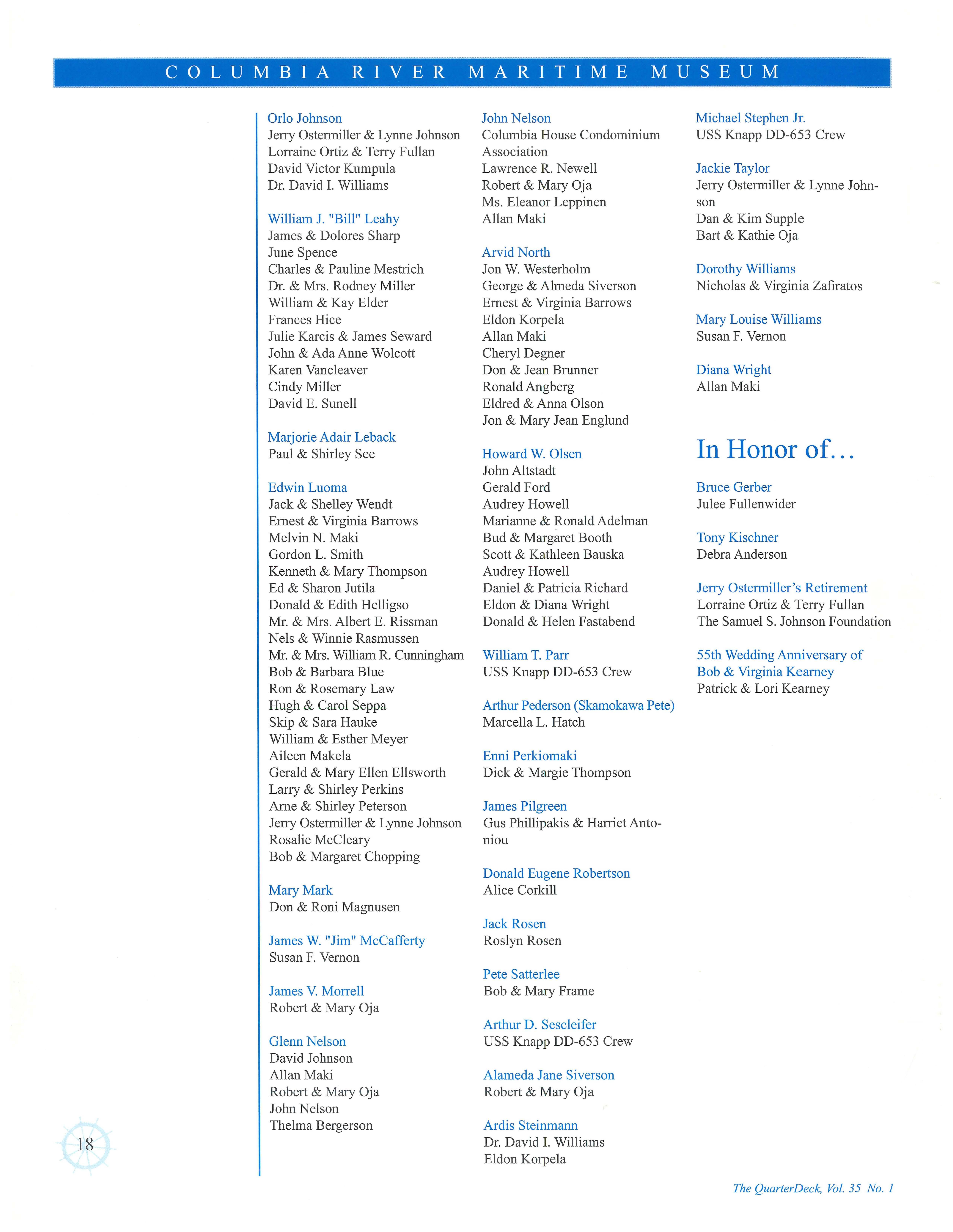
Mr. & Mrs. William R. Cunningham William T Parr
55th Wedding Anniversary of Bob & Barbara Blue USS Knapp DD-653 Crew Bob & Virginia Kearney Ron & Rosemary Law Patrick & Lori Kearney Hugh & Carol Seppa Arthur Pederson (Skamokawa Pete) Skip & Sara Hauke Marcella L. Hatch William & Esther Meyer Aileen Makela Enni Perkiomaki Gerald & Mary Ellen Ellsworth Dick & Margie Thompson Larry & Shirley Perkins Ame & Shirley Peterson James Pilgreen Jerry Ostermiller & Lynne Johnson Gus Phillipakis & Harriet AntoRosalie McCleary mou Bob & Margaret Chopping
Donald Eugene Robertson
Mary Mark Alice Corkill Don & Roni Magnusen
Jack Rosen
James W. "Jim" McCafferty Roslyn Rosen Susan F Vernon
Pete Satterlee
James V. Morrell Bob & Mary Frame Robert & Mary Oja
Arthur D. Sescleifer
Glenn Nelson USS Knapp DD-653 Crew
David Johnson
Allan Maki
Alameda Jane Siverson Robert & Mary Oja Robert & Mary Oja John Nelson Thelma Bergerson
Ardis Steinmann
Dr. David I. Williams Eldon Korpela

The Museum has published an exclusive new coloring book of ships found on the Columbia River. The book, found only in the Museum Store, is illustrated by Columbia River Maritime Museum Museum Educator Nathan Sandel. Call the Museum Store at (503) 325-2323 order your copy. All proceeds go to support the Museum.
